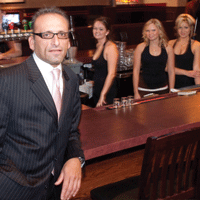Ontario-based chain adapts to the changing marketplace with new, smaller-footprint units
History has proven time and time again that extreme hardship can inspire great accomplishments. Modern democracy was borne out of the bloody American and French Revolutions. A new standard for equality emerged from the determined activism of the civil rights movement. And after four decades of losing, the Toronto Maple Leafs are currently poised to climb into the upper echelons of the National Hockey League. (Just 29 more teams stand in the way!)
For Shoeless Joe’s, a Toronto-based family casual chain with 35 locations in Ontario, the recent economic downturn provided the ideal backdrop for opening its first smaller-concept unit. Similar to the downsized Fionn MacCool’s pubs that were launched by Mississauga, Ont.’s Prime Restaurants last year, the 3,300-square-foot Shoeless Joe’s feature all the bells and whistles of larger units, including a full-line kitchen. The menus are also the same at the smaller stores, so as not to confuse customers. Cheaper to purchase and operate, they’re perfect for potential franchisees looking for value.
Yet Joel Friedman, senior vice-president of Franchising and Real Estate, stresses the streamlined stores were not developed solely in reaction to the recession. “When I joined this company more than a year and a half ago, we were already interested in breaking into areas where we couldn’t go,” Friedman says, one blustery Friday from inside the newest Shoeless Joe’s in Toronto’s Yonge and Sheppard neighbourhood. The new stores are designed to fit into a variety of snug plots and they’re customizable, too, a key incentive for attracting finicky investors.
Located in an upscale condo development’s retail and office space extension with prime frontage facing busy Sheppard Ave., the eatery is the chain’s first truncated store. (Regular Shoeless Joe’s restaurants range in size from 5,400 up to 7,200 square feet.) Designed by MacKay Wong, the sleek, modern space has large open windows and high ceilings, but upon entering it’s clearly smaller than usual (a server with average arm-strength and accuracy could easily zing a bottle of mustard from one side of the room to the other — not that it’s recommended). A standard bar area sits on the left filled with high-top tables and booths, with an equal-size dining room opposite. The one feature that truly stands out is the horseshoe-shaped centre bar. Not tucked away on a back wall or crammed into a corner, it’s both a visual centrepiece for the space and an operational hub (see sidebar). Hanging over the bar is a large drop-down wall with flat-screen TVs and a glass case showcasing the de rigueur sporting memorabilia. It is your average, everyday sports bar/restaurant — just smaller.
Friedman says the decision to launch the smaller-footprint units was an evolution of the brand and the growth it wants to achieve each year. “We didn’t choose to go smaller just because of the recession,” he says. “We wanted to see where else we could go with our restaurants. Now, it does have a little bit to do with the economy, especially when it comes to rent. For instance, in the building across the street [the Sheppard Centre] they were asking for $100 per square foot, and I couldn’t afford it. Here, rent is much cheaper.”
Inexpensive rent is an attractive proposition for new franchisees, especially during a recession. So is the unit’s ticket price. The small stores are about $550,000 plus working capital (bigger units cost $750,000 plus working capital). Factor in substantially reduced overhead and the company has just opened itself up to a whole new range of potential franchisees.
The executive also emphasizes there are advantages to opening a restaurant during a recession as opposed to during a boom. “In boom times, operators are fat. You’re running your labour fat, you’re running your food costs fat and you’re real estate fat,” he says. “In recessions, franchisees learn how to run things tight. And then when things get better [or if they get worse], they’ll know how to react.”
OK, but has it translated into a boost in franchise sales? “We have 10 locations opening in the next year,” Friedman says proudly. “In any recession, there are people that have been laid off or are looking to make a different kind of investment. You always see a spike in franchising during a recession.”
Recessionary factors aside, the real thrust behind the launch of the smaller units comes from increasing the customization and portfolio diversity available to franchisees — in turn, giving them more options — in what’s long been a rigid marketplace. Shoeless Joe’s has been tracking how the industry has been evolving for years; franchisees can now break into the restaurant business in many different markets and through a number of varying real estate plays. “With this new concept we can open in non-traditional venues such as condos, hotels, airports or movies theatres,” says Friedman.
For example, franchisee Siva Subramaniam’s ground-floor condo location at Yonge and Sheppard is currently accessible from the street. But a second tower is in the works and his restaurant will soon feature an interior entrance specifically designed for condo dwellers — a nice value add for customers during the cold winter months.
All these incentives enticed Subramaniam back into the franchisee fold after a brief absence. Though he’s been with Shoeless for almost 15 years, he previously sold two restaurants once the smoking ban came into effect. “When the smoking bylaw hit, my sales went down 40 per cent,” he recalls. “I had even built a smoking room to appease the new law, and after nine months they said, ‘no smoking at all.’”
Today, customers are used to the smoking situation, he says. Together with the number of options he has in terms of size of unit, site and area selection, alongside the strength of the brand and his good relationship with head office, he’s excited to expand his Shoeless portfolio. He prefers smaller stores, he says, though it depends on the area.
“In this economy, nobody wants to invest $1 million,” Subramaniam says. “The smaller concept requires less overhead and it’s easier to monitor and manage. Then there’s labour; my restaurant has only 93 seats, and weekdays I only have four people on the line. When you have a 230-seat restaurant, you need at least six people on the line.”
At his old locations, if there wasn’t a big sporting event on any given night, they were half empty, which led to scheduling problems. “Now, at lunchtime I have three servers and one bartender. Sometimes I have one hostess and one bartender.”
Although another 3,330-square-foot store at Eglinton and Laird is in the works in Toronto, the goal isn’t to eliminate the regular-sized units. In fact, Shoeless has a 200-seat store currently being built in London, Ont., and Friedman says he’s looking to sign a deal for a 7,200-square-foot unit. “We want to maintain a real mixture in the portfolio.”
Editor’s note: for more on Shoeless Joe’s franchisee and site selection process, see foodserviceandhospitality.com/foodservice-and-hospitality-mag/ web-exclusives.html.





















